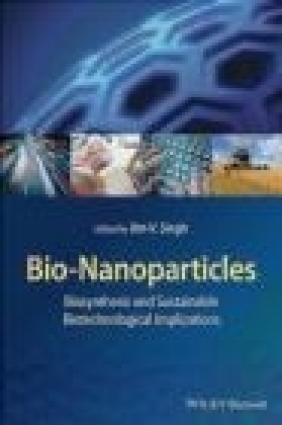Bio-Nanoparticles
Bio-Nanoparticles
- Wydawnictwo: John Wiley
- Rok wydania: 2015
- ISBN: 9781118677681
- Ilość stron: 384
- Oprawa: Twarda
Niedostępna
Opis: Bio-Nanoparticles
Nanoparticles are the building blocks for nanotechnology; they are better built, long lasting, cleaner, safer, and smarter products for use across industries, including communications, medicine, transportation, agriculture and other industries. Controlled size, shape, composition, crystallinity, and structure-dependent properties govern the unique properties of nanotechnology. Bio-Nanoparticles: Biosynthesis and Sustainable Biotechnological Implications explores both the basics of and advancements in nanoparticle biosynthesis. The text introduces the reader to a variety of microorganisms able to synthesize nanoparticles, provides an overview of the methodologies applied to biosynthesize nanoparticles for medical and commercial use, and gives an overview of regulations governing their use. Authored by leaders in the field, Bio-Nanoparticles: Biosynthesis and Sustainable Biotechnological Implications bridges the gap between biology and technology, and is an invaluable resource for students and researchers alike.List of Contributors xv Introduction xvii 1 Diversity of Microbes in Synthesis of Metal Nanoparticles: Progress and Limitations 1 Mahendra Rai, Irena Maliszewska, Avinash Ingle, Indarchand Gupta, and Alka Yadav 1.1 Introduction 1 1.2 Synthesis of Nanoparticles by Bacteria 2 1.3 Synthesis of Nanoparticles by Fungi 9 1.4 Synthesis of Nanoparticles by Algae 12 1.5 Applications of Metal Nanoparticles 16 1.5.1 Nanoparticles as Catalyst 16 1.5.2 Nanoparticles as Biou]membranes 17 1.5.3 Nanoparticles in Cancer Treatment 17 1.5.4 Nanoparticles in Drug Delivery 17 1.5.5 Nanoparticles for Detection and Destruction of Pesticides 17 1.5.6 Nanoparticles in Water Treatment 18 1.6 Limitations of Synthesis of Biogenic Nanoparticles 18 References 20 2 Role of Fungi Toward Synthesis of Nanou]Oxides 31 Rajesh Ramanathan and Vipul Bansal 2.1 Introduction 31 2.2 Fungusu]mediated Synthesis of Nanomaterials 34 2.2.1 Biosynthesis of Binary Nanou]oxides using Chemical Precursors 34 2.2.2 Biosynthesis of Complex Mixedu]metal Nanou]oxides using Chemical Precursors 39 2.2.3 Biosynthesis of Nanou]oxides using Natural Precursors employing Bioleaching Approach 42 2.2.4 Biosynthesis of nanou]oxides employing biou]milling approach 44 2.3 Outlook 46 References 47 3 Microbial Molecular Mechanisms in Biosynthesis of Nanoparticles 53 Atmakuru Ramesh, Marimuthu Thiripura Sundari, and Perumal Elumalai Thirugnanam 3.1 Introduction 53 3.2 Chemical Synthesis of Metal Nanoparticles 54 3.2.1 Brust-Schiffrin Synthesis 55 3.3 Green Synthesis 57 3.4 Biosynthesis of Nanoparticles 58 3.5 Mechanisms for Formation or Synthesis of Nanoparticles 61 3.5.1 Biomineralization using Magnetotactic Bacteria (MTB) 61 3.5.2 Reduction of Tellurite using Phototroph Rhodobacter capsulatus 62 3.5.3 Formation of AgNPs using Lactic Acid and Bacteria 62 3.5.4 Microfluidic Cellular Bioreactor for the Generation of Nanoparticles 62 3.5.5 Proteins and Peptides in the Synthesis of Nanoparticles 65 3.5.6 NADHu]dependent Reduction by Enzymes 65 3.5.7 Sulfate and Sulfite Reductase 66 3.5.8 Cyanobacteria 67 3.5.9 Cysteine Desulfhydrase in Rhodopseudomonas palustris 68 3.5.10 Nitrate and Nitrite reductase 68 3.6 E xtracellular Synthesis of Nanoparticles 69 3.6.1 Bacterial Excretions 69 3.6.2 Fungal Strains 71 3.6.3 Yeast: Oxidou]reductase Mechanism 72 3.6.4 Plant Extracts 73 3.7 Conclusion 76 References 78 4 Biofilms in Biou]Nanotechnology: Opportunities and Challenges 83 Chun Kiat Ng, Anee Mohanty, and Bin Cao 4.1 Introduction 83 4.2 Microbial Synthesis of Nanomaterials 84 4.2.1 Overview 84 4.2.2 Significance of Biofilms in Biosynthesis of Nanomaterials 89 4.2.3 Synthesis of Nanomaterials using Biofilms 90 4.3 Interaction of Microbial Biofilms with Nanomaterials 90 4.3.1 Nanomaterials as Antiu]biofilm Agents 90 4.3.2 Nanomaterials as a Tool in Biofilm Studies 92 4.4 Future Perspectives 93 References 94 5 Extremophiles and Biosynthesis of Nanoparticles: Current and Future Perspectives 101 Jingyi Zhang, Jetka Wanner, and Om V. Singh 5.1 Introduction 101 5.2 Synthesis of Nanoparticles 104 5.2.1 Microorganisms: An Asset in Nanoparticle Biosynthesis 104 5.2.2 E xtremophiles in Nanoparticle Biosynthesis 104 5.3 Mechanism of Nanoparticle Biosynthesis 108 5.4 Fermentative Production of Nanoparticles 111 5.5 Nanoparticle Recovery 114 5.6 Challenges and Future Perspectives 115 5.7 Conclusion 115 References 116 6 Biosynthesis of Size-Controlled Metal and Metal Oxide Nanoparticles by Bacteria 123 Chung-Hao Kuo, David A. Kriz, Anton Gudz, and Steven L. Suib 6.1 Introduction 123 6.2 Intracellular Synthesis of Metal Nanoparticles by Bacteria 124 6.3 E xtracellular Synthesis of Metal Nanoparticles by Bacteria 129 6.4 Synthesis of Metal Oxide and Sulfide Nanoparticles by Bacteria 131 6.5 Conclusion 135 References 135 7 Methods of Nanoparticle Biosynthesis for Medical and Commercial Applications 141 Shilpi Mishra, Saurabh Dixit, and Shivani Soni 7.1 Introduction 141 7.2 Biosynthesis of Nanoparticles using Bacteria 144 7.2.1 Synthesis of Silver Nanoparticles by Bacteria 144 7.2.2 Synthesis of Gold Nanoparticles by Bacteria 145 7.2.3 Synthesis of other Metallic Nanoparticles by Bacteria 145 7.3 Biosynthesis of Nanoparticles using Actinomycete 146 7.4 Biosynthesis of Nanoparticles using Fungi 147 7.5 Biosynthesis of Nanoparticles using Plants 148 7.6 Conclusions 149 References 149 8 Microbial Synthesis of Nanoparticles: An Overview 155 Sneha Singh, Ambarish Sharan Vidyarthi, and Abhimanyu Dev 8.1 Introduction 156 8.2 Nanoparticles Synthesis Inspired by Microorganisms 157 8.2.1 Bacteria in NPs Synthesis 162 8.2.2 Fungi in NPs Synthesis 167 8.2.3 Actinomycetes in NPs Synthesis 170 8.2.4 Yeast in NPs Synthesis 171 8.2.5 Virus in NPs Synthesis 173 8.3 Mechanisms of Nanoparticles Synthesis 174 8.4 Purification and Characterization of Nanoparticles 176 8.5 Conclusion 177 References 179 9 Microbial Diversity of Nanoparticle Biosynthesis 187 Raveendran Sindhu, Ashok Pandey, and Parameswaran Binod 9.1 Introduction 187 9.2 Microbial-mediated Nanoparticles 187 9.2.1 Gold 188 9.2.2 Silver 190 9.2.3 Selenium 191 9.2.4 Silica 192 9.2.5 Cadmium 192 9.2.6 Palladium 193 9.2.7 Zinc 193 9.2.8 Lead 194 9.2.9 Iron 195 9.2.10 Copper 195 9.2.11 Cerium 196 9.2.12 Microbial Quantum Dots 196 9.2.13 Cadmium Telluride 197 9.2.14 Iron Sulfide-greigite 198 9.3 Native and Engineered Microbes for Nanoparticle Synthesis 198 9.4 Commercial Aspects of Microbial Nanoparticle Synthesis 199 9.5 Conclusion 200 References 200 10 S ustainable Synthesis of Palladium(0) Nanocatalysts and their Potential for Organohalogen Compounds Detoxification 205 Michael Bunge and Katrin Mackenzie 10.1 Introduction 205 10.2 Chemically Generated Palladium Nanocatalysts for Hydrodechlorination: Current Methods and Materials 206 10.2.1 Pd Catalysts 206 10.2.2 Data Analysis 207 10.2.3 Pd as Dehalogenation Catalyst 207 10.2.4 Intrinsic Potential vs. Performance 208 10.2.5 Concepts for Pd Protection 210 10.3 Bio-supported Synthesis of Palladium Nanocatalysts 211 10.3.1 Background 211 10.4 Current Approaches for Synthesis of Palladium Catalysts in the Presence of Microorganisms 212 10.4.1 Pd(II)-Tolerant Microorganisms for Future Biotechnological Approaches 213 10.4.2 Controlling Size and Morphology during Bio-Synthesis 214 10.4.3 Putative and Documented Mechanisms of Biosynthesis of Palladium Nanoparticles 215 10.4.4 Isolation of Nanocatalysts from the Cell Matrix and Stabilization 216 10.5 Bio-Palladium(0)-nanocatalyst Mediated Transformation of Organohalogen Pollutants 217 10.6 Conclusions 218 References 219 11 E nvironmental Processing of Zn Containing Wastes and Generation of Nanosized Value-Added Products 225 Abhilash and B.D. Pandey 11.1 Introduction 225 11.1.1 World Status of Zinc Production 226 11.1.2 E nvironmental Impact of the Process Wastes Generated 226 11.1.3 Production Status in India 227 11.1.4 Recent Attempts at Processing Low-Grade Ores and Tailings 228 11.2 Physical/Chemical/Hydrothermal Processing 229 11.2.1 E xtraction of Pb-Zn from Tailings for Utilization and Production in China 229 11.2.2 Vegetation Program on Pb-Zn Tailings 229 11.2.3 Recovering Valuable Metals from Tailings and Residues 229 11.2.4 E xtraction of Vanadium, Lead and Zinc from Mining Dump in Zambia 230 11.2.5 Recovery of Zinc from Blast Furnace and other Dust/Secondary Resources 230 11.2.6 Treatment and Recycling of Goethite Waste 231 11.2.7 Other Hydrometallurgical Treatments of Zinc-based Industrial Wastes and Residues 231 11.3 Biohydrometallurgical Processing: International Scenario 233 11.3.1 Bioleaching of Zn from Copper Mining Residues by Aspergillus niger 233 11.3.2 Bioleaching of Zinc from Steel Plant Waste using Acidithiobacillus ferrooxidans 234 11.3.3 Bacterial Leaching of Zinc from Chat (Chert) Pile Rock and Copper from Tailings Pond Sediment 234 11.3.4 Dissolution of Zn from Zinc Mine Tailings 234 11.3.5 Microbial Diversity in Zinc Mines 234 11.3.6 Chromosomal Resistance Mechanisms of A. ferrooxidans on Zinc 235 11.3.7 Bioleaching of Zinc Sulfides by Acidithiobacillus ferrooxidans 235 11.3.8 Bioleaching of High-sphalerite Material 235 11.3.9 Bioleaching of Low-grade ZnS Concentrate and Complex Sulfides (Pb-Zn) using Thermophilic Species 236 11.3.10 Improvement of Stains for Bio-processing of Sphalerite 236 11.3.11 Tank Bioleaching of ZnS and Zn Polymetallic Concentrates 237 11.3.12 Large-Scale Development for Zinc Concentrate Bioleaching 237 11.3.13 Scale-up Studies for Bioleaching of Low-Grade Sphalerite Ore 238 11.3.14 Zinc Resistance Mechanism in Bacteria 238 11.4 Biohydrometallurgical Processing: Indian Scenario 238 11.4.1 E lectro-Bioleaching of Sphalerite Flotation Concentrate 239 11.4.2 Bioleaching of Zinc Sulfide Concentrate 239 11.4.3 Bioleaching of Moore Cake and Sphalarite Tailings 239 11.5 Synthesis of Nanoparticles 240 11.6 Applications of Zinc-based Value-added Products/Nanomaterials 244 11.6.1 Hydro-Gel for Bio-applications 244 11.6.2 Sensors 244 11.6.3 Biomedical Applications 245 11.6.4 Antibacterial Properties 245 11.6.5 Zeolites in biomedical applications 246 11.6.6 Textiles 246 11.6.7 Prospects of Zinc Recovery from Tailings and Biosynthesis of Zinc-based Nano-materials 246 11.7 Conclusions and Future Directions 247 References 248 12 Interaction Between Nanoparticles and Plants: Increasing Evidence of Phytotoxicity 255 Rajeshwari Sinha and S.K. Khare 12.1 Introduction 255 12.2 Plant-Nanoparticle Interactions 256 12.3 E ffect of Nanoparticles on Plants 256 12.3.1 Monocot Plants 257 12.3.2 Dicot Plants 257 12.4 Mechanisms of Nanoparticleu]induced Phytotoxicity 257 12.4.1 Endocytosis 257 12.4.2 Transfer through Ion Channels Postu]ionization 262 12.4.3 Aquaporin Mediated 262 12.4.4 Carrier Proteins Mediated 262 12.4.5 Via Organic Matter 262 12.4.6 Complex Formation with Root Exudates 262 12.4.7 Foliar Uptake 263 12.5 E ffect on Physiological Parameters 263 12.5.1 Loss of Hydraulic Conductivity 263 12.5.2 Genotoxic Effects 263 12.5.3 Absorption and Accumulation 263 12.5.4 Generation of Reactive Oxygen Species (ROS) 264 12.5.5 Biotransformation of NPs 264 12.6 Genectic and Molecular Basis of NP Phytotoxicity 266 12.7 Conclusions and Future Perspectives 266 References 267 13 Cytotoxicology of Nanocomposites 273 Horacio Bach 13.1 Introduction 273 13.2 Cellular Toxicity 274 13.2.1 Mechanisms of Cellular Toxicity 274 13.2.2 E ffect of Glutathione (GSH) in Oxidative Stress 276 13.2.3 Damage to Cellular Biomolecules 277 13.3 Nanoparticle Fabrication 281 13.3.1 Physicou]chemical Characteristics of NPs 282 13.3.2 Cellular Uptake 284 13.3.3 Factors Affecting the Internalization of NPs 287 13.4 Immunological Response 289 13.4.1 Cytokine Production 289 13.4.2 Cytotoxicity, Necrosis, Apoptosis, and Cell Death 290 13.5 Factors to Consider to Reduce the Cytotoxic Effects of NP 292 13.6 Conclusions and Future Directions 293 References 294 14 Nanotechnology: Overview of Regulations and Implementations 303 Om V. Singh and Thomas Colonna 14.1 Introduction 303 14.2 Scope of Nanotechnology 305 14.3 Safety Concerns Related to Nanotechnology 310 14.4 Barriers to the Desired Regulatory Framework 311 14.4.1 Regulatory Framework in the United States 312 14.4.2 Global Efforts toward Regulation of Nanotechnology 315 14.5 Biosynthesis of Microbial Biou]nanoparticles: An Alternative Production Method 317 14.6 Conclusion 325 References 326 Name index 331 Subject index 333
Szczegóły: Bio-Nanoparticles
Tytuł: Bio-Nanoparticles
Wydawnictwo: John Wiley
ISBN: 9781118677681
Rok wydania: 2015
Ilość stron: 384
Oprawa: Twarda
Waga: 0.77 kg






























